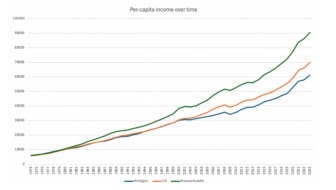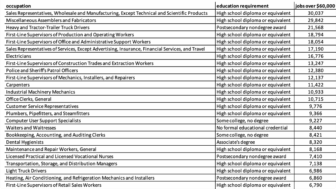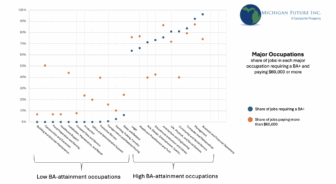On Wednesday I wrote about how women in particular are doing in Michigan’s–and the world’s–changing economy. I started by sharing data on single women-led households with children, who are more likely than not to be living in poverty. Then I took a look at educational achievement. Today I turn to income and employment, health, and leadership.
Keep in mind that in my last post, I shared data that show that, for the most part, women and men are performing comparably in educational achievement, including college and advanced degree attainment, when you look at this table.
Table. Median income, 2016 ACS, population 25 and over with earnings.
| Educational Attainment |
Male |
Female |
| All workers |
$42,386 |
$28,204 |
| Less than a high school degree |
$22,912 |
$14,018 |
| High school grad (or equivalency) |
$32,330 |
$20,910 |
| Some college or associate’s degree |
$41,115 |
$25,875 |
| Bachelor’s degree |
$62,014 |
$40,025 |
| Graduate or professional degree |
$82,635 |
$57,187 |
Yes, you are reading that right: men with only some college tend to make more than women with a bachelor’s degree, and men with a bachelor’s degree make more than women with an advanced degree.
ALICE’s household survival budget for a family of four is just over $56,000. This means that more than half of women with a college degree couldn’t support their household alone at a survival level. They don’t reach that level of income security unless they have a graduate degree. (Of course, that’s still significantly better than the alternative–as you can see, lower education levels equal significantly lower pay.)
In other words: no wonder single female-led households can’t achieve financial security for themselves and their children.
Again, as you read, keep in mind the almost identical levels of educational achievement. In the three occupations with the highest annual median earnings in Michigan (according to BLS), women range from being underrepresented to what I like to call “woefully underrepresented” (architecture and engineering occupations at 13.3 percent—I’m looking at you!). On the other end of the spectrum, in the two lowest-paying occupations in the state, women are overrepresented. And unfortunately, some of our lowest-paying occupations are also the most common. For instance, in the service occupations, where Michigan’s women have 60 percent of the jobs, the ALICE report tells us that only five of the top 20 most common occupations pay enough to meet the ALICE threshold. ALICE also tells us that the most common occupation in Michigan, retail salespersons, make an hourly wage of only $10.06. If working full-time (not all are), a person earning this figure would make $20,120 annually. I.e., “These jobs fall short of meeting the family Household Survival Budget by more than $36,000 per year.”
9.7 percent of employed Michigan women are living below the federal poverty line (the number is 41 percent for unemployed women, compared with 6.7 percent and 35.1 percent of men, in the respective categories).
Health
Moving on to a different area—I found the United Health Foundation’s America’s Health Rankings, released in 2016, which organizes a ton of data (primarily from the CDC) on women and children’s health, by state (their online tool is great if you are curious). I picked a couple of key indicators based on data points I’d seen in other reports: having adequate health insurance, maternal mortality rates, substance abuse, and public funding of women’s health services. The one bright spot in Michigan’s data is health insurance, where Michigan ranks 13th in the nation, with 78.7 percent of women covered.
Women’s substance abuse is at troubling levels: we are ranked 37th in drug deaths and 40th in women’s excessive drinking. Michigan is 33rd in maternal mortality. And we are 45th in the public funding of women’s health services. (I didn’t go looking for this stat—but I couldn’t help but note that we have the 44th worst rate of intimate partner violence, with 41.8 percent of Michigan women experiencing it over their lifetime. Not good.)
Leadership
Finally, just for grins/frowns, I counted the number of women in Michigan’s state house and senate. This may not surprise you, but the percentage in the house is less than 30 percent. That’s better than the state senate, where only 13 percent of the chamber are women.
Summary
So, we get paid less and are more likely to be living in poverty or just barely getting by, our health outcomes aren’t pretty, in only six other states would we have worse odds of being abused by a domestic partner, and we aren’t being elected as leaders. At least we have health insurance.
While I don’t get into policy in this post—and this is an area where there is a lot of disagreement about what the role of policy even should even be—our shared prosperity recommendations are relevant for improving the lives of all families living near or below the ALICE threshold.
I can’t imagine anyone arguing that we should be content with the status quo.







